| Listing 1 - 10 of 56 | << page >> |
Sort by
|
Book
ISBN: 9780764209017 Year: 2011 Publisher: Minneapolis, Minnesota Bethany House Publishers
Abstract | Keywords | Export | Availability | Bookmark
 Loading...
Loading...Choose an application
- Reference Manager
- EndNote
- RefWorks (Direct export to RefWorks)
Mormonism --- testimony --- temple Mormons --- the latter-day Saints --- the LDS Church --- Judy Robertson
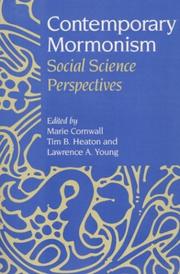
ISBN: 0252069595 Year: 2001 Publisher: Urbana The University of Illinois Press
Abstract | Keywords | Export | Availability | Bookmark
 Loading...
Loading...Choose an application
- Reference Manager
- EndNote
- RefWorks (Direct export to RefWorks)
Mormonism --- sociological perspective on Mormonism --- social science research --- secularization --- assimilation --- church growth --- patriarchy --- gender roles --- globalization of the LDS church
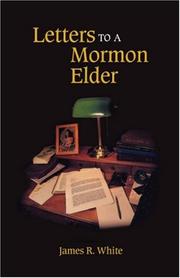
ISBN: 1599251191 Year: 1993 Publisher: Vestavia Hills AL Solid Grounds Christian Books
Abstract | Keywords | Export | Availability | Bookmark
 Loading...
Loading...Choose an application
- Reference Manager
- EndNote
- RefWorks (Direct export to RefWorks)
God's Word --- Mormonism --- the Bible --- the Church of Jesus Christ of latter-day Saints --- Christianity --- the Book of Mormon --- Joseph Smith --- the LDS Church
Book
ISBN: 9780825442681 Year: 2012 Publisher: Grand Rapids, MI Kregel Publications / Kregel, Inc.
Abstract | Keywords | Export | Availability | Bookmark
 Loading...
Loading...Choose an application
- Reference Manager
- EndNote
- RefWorks (Direct export to RefWorks)
Mormonism --- American religious movements --- the Mormon Church --- Latter-day Saints --- doctrine --- the Bible --- Christianity --- God's word --- the LDS Church --- God --- salvation --- Joseph Smith --- the Book of Mormon
Book
ISBN: 1479841498 1479822493 9781479822492 9781479847990 1479847992 9781479816026 1479816027 9781479841493 Year: 2015 Publisher: New York, NY
Abstract | Keywords | Export | Availability | Bookmark
 Loading...
Loading...Choose an application
- Reference Manager
- EndNote
- RefWorks (Direct export to RefWorks)
Women in New Religions offers an engaging look at women’s evolving place in the birth and development of new religious movements. It focuses on four disparate new religions—Mormonism, Seventh-day Adventism, The Family International, and Wicca—to illuminate their implications for gender socialization, religious leadership and participation, sexuality, and family ideals. Religious worldviews and gender roles interact with one another in complicated ways. This is especially true within new religions, which frequently set roles for women in ways that help the movements to define their boundaries in relation to the wider society. As new religious movements emerge, they often position themselves in opposition to dominant society and concomitantly assert alternative roles for women. But these religions are not monolithic: rather than defining gender in rigid and repressive terms, new religions sometimes offer possibilities to women that are not otherwise available. Vance traces expectations for women as the religions emerge, and transformation of possibilities and responsibilities for women as they mature. Weaving theory with examination of each movement’s origins, history, and beliefs and practices, this text contextualizes and situates ideals for women in new religions. The book offers an accessible analysis of the complex factors that influence gender ideology and its evolution in new religious movements, including the movements’ origins, charismatic leadership and routinization, theology and doctrine, and socio-historical contexts. It shows how religions shape definitions of women’s place in a way that is informed by response to social context, group boundaries, and identity. Additional Resources
Women and religion. --- Mormon women. --- Seventh-Day Adventist women. --- Wicca. --- Wica --- Neopaganism --- Witchcraft --- Christian women --- Women, Mormon --- Religion and women --- Women in religion --- Religion --- Sexism in religion --- Family International (Organization) --- Family (Organization) --- Wiccakult --- Frau. --- Neue Religion --- Frau --- Gemeinschaft der Siebenten-Tags-Adventisten --- Mormonen --- Mormon Church --- Heilige der Letzten Tage --- HLT-Kirche --- Kirche Jesu Christi der Heiligen der Letzten Tage --- Church of Jesus Christ of Latter Day Saints --- Latter Day Saints --- Église de Jésus Christ des Saints des Derniers Jours --- Church of Latter Day Saints --- Church of Christ --- Church of Jesus Christ of Latter-day Saints --- LDS Church --- Religionsgemeinschaft --- Salt Lake City, Utah --- 1830 --- -Family (Organization) --- Mormon women --- Latter Day Saint women. --- women in new religions --- Mormonism --- Seventh-day Adventism --- endtime religion --- The Family International --- sexualizing gender --- Wicca --- the Divine Feminine
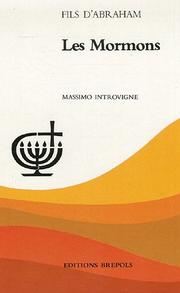
ISBN: 2503500633 2503500641 9782503500645 9782503500638 Year: 1991 Volume: *37 Publisher: Bruxelles Brepols
Abstract | Keywords | Export | Availability | Bookmark
 Loading...
Loading...Choose an application
- Reference Manager
- EndNote
- RefWorks (Direct export to RefWorks)
L'introduction de trois pages indique que, si les Témoins se défendent de faire partie de "Babylone la Grande", ils proviennent bien d'une grande lignée religieuse : ils sont un rejeton du mouvement initié par Charles Taze Russell, des Étudiants de la Bible, qui s'inspirait des doctrines adventistes, courant ayant lui-même vu le jour sous l'impulsion de William Miller, un baptiste qui ne raviva le millénarisme au sein du christianisme. L'auteur identifie Joseph Rutherford, successeur de Russell à la présidence de la Société Watch Tower, au véritable fondateur des Témoins.Le livre se divise en plusieurs chapitres qui correspondent au plan de tous autres livres de la collection "Fils d'Abraham". La premier chapitre aborde l'histoire du mouvement en retraçant son évolution depuis l'attente du retour du Christ par les millérites en 1844 jusqu'à la fin des années 1980; il montre les évolutions successives du mouvement, du prophétisme de Russell en passant par la crise de succession et les dissidences, pour finalement aboutir à une secte routinisée et de plus en plus structurée, et évoque la crise post-1975. Le second chapitre est consacrée à la doctrine, soulignant la marque millénariste du groupe, son mode d'interprétation de la Bible, son rejet de la Trinité, la domination du monde par Satan, les dates prophétiques et l'eschatologie.Le troisième chapitre consacré à l'anthologie reproduit des passages tirés de textes des influences doctrinales de Russell (William Miller, George Storrs, Jonas Wendell, Nelson Barbour), de ses premiers collaborateurs (Albert Jones, John Paton), de Russell lui-même, de l'oraison funèbre qui eut lieu à sa mort, de Rutherford, et des ouvrages ultérieurement édités par la Watch Tower. Ces citations sont intéressantes car elles sont généralement méconnues du grand public et des adeptes, et permettent de souligner l'évolution de la doctrine au fil des années tout en indiquant la permanence des attentes millénaristes, fournissant les justifications théoriques de certaines règles du mouvement.Le quatrième chapitre, assez court — et pour cause: il n'y a pas grand chose à dire... —, met en valeur le désintérêt du mouvement pour toute forme artistique. Un cinquième s'intéresse à la vie spirituelle, montrant comment le petit groupe mystique des premiers temps s'est totalement muté en une organisation totalement orientée sur le prosélytisme sous Rutherford. Un sixième chapitre se penche sur le profil sociologique du groupe, étudiant les canaux de conversion, le type de personnes attirées, le rapport au monde, les facteurs de cohésion du groupe, la répartition des adeptes dans le monde et l'efficacité du prosélytisme. Enfin, un septième chapitre aborde l'organisation, présentée comme pyramidale, et le financement.La bibliographie, très abondante, regroupe des publications provenant tant des Étudiants de la Bible, des Témoins de Jéhovah, de leurs mouvements schismatiques, de leurs critiques et des chercheurs. L'annexe se compose de schémas permettant de visualiser la place des Étudiants de la Bible par rapport à l'adventisme ainsi que les schismes du mouvement, de cartes indiquant la répartition des adeptes par pays, de statistiques sur l'évolution des effectifs dans sa globalité et par pays. Enfin, après la table des matières, quelques photos et desseins, dont plusieurs illustrations tirées des publications, sont reproduits
Church of Jesus Christ of Latter-Day Saints --- Eglise de Jésus-Christ des saints des derniers jours --- Eglise mormone --- Kerk van Jezus Christus van de Heiligen der Laatste Dagen --- LDS Church --- Mormon Church --- Mormonen --- Mormons --- Mormoonse Kerk --- Mormons and Mormonism --- Mormons et mormonisme --- History --- Histoire --- Jehovah's Witnesses --- Témoins de Jéhova --- Témoins de Jéhovah --- getuigen van Jehovah (Jehovahgetuigen) --- 289.954 --- témoins de Jéhovah --- Getuigen van Jehovah. Ernste Bibelforscher. Watch Tower --- 289.3 --- Mormonen. Church of Jesus Christ of Latter Day Saints --- 289.954 Getuigen van Jehovah. Ernste Bibelforscher. Watch Tower --- 289.3 Mormonen. Church of Jesus Christ of Latter Day Saints --- Témoins de Jéhova --- Mormons - Histoire --- Etats-Unis --- Etudiants de la Bible --- Babylone --- la Trinité --- le retour du Christ --- la fin du monde --- 1914 --- 1975 --- la Bible --- mouvements religieux --- transfusion sanguine --- objection de conscience --- baptêmes par immersion --- spiritualité --- prosélytisme --- 1830 --- Joseph Smith --- l'Eglise de Jésus-Christ des Saints des Derniers Jours --- les Mormons --- l'Eglise mormone --- 1890 --- la polygamie --- l'Utah
Book
ISBN: 9781400890316 1400890314 9780691196848 Year: 2018 Publisher: Princeton, NJ
Abstract | Keywords | Export | Availability | Bookmark
 Loading...
Loading...Choose an application
- Reference Manager
- EndNote
- RefWorks (Direct export to RefWorks)
A history of unparalleled scope that charts the global transformation of Christianity during an age of profound political and cultural changeChristianity in the Twentieth Century charts the transformation of one of the world's great religions during an age marked by world wars, genocide, nationalism, decolonization, and powerful ideological currents, many of them hostile to Christianity. Written by a leading scholar of world Christianity, the book traces how Christianity evolved from a religion defined by the culture and politics of Europe to the expanding polycentric and multicultural faith it is today--one whose growing popular support is strongest in sub-Saharan Africa, Latin America, China, and other parts of Asia.Brian Stanley sheds critical light on themes of central importance for understanding the global contours of modern Christianity, illustrating each one with contrasting case studies, usually taken from different parts of the world. Unlike other books on world Christianity, this one is not a regional survey or chronological narrative, nor does it focus on theology or ecclesiastical institutions. Rather, Stanley provides a history of Christianity as a popular faith experienced and lived by its adherents, telling a compelling and multifaceted story of Christendom's fortunes in Europe, North America, and across the rest of the globe.Transnational in scope and drawing on the latest scholarship, Christianity in the Twentieth Century demonstrates how Christianity has had less to fear from the onslaughts of secularism than from the readiness of Christians themselves to accommodate their faith to ideologies that privilege racial identity or radical individualism. "Charts the transformation of one of the world's great religions during an age marked by world wars, genocide, nationalism, decolonization, and powerful ideological currents, many of them hostile to Christianity. Written by a leading scholar of world Christianity, the book traces how Christianity evolved from a religion defined by the culture and politics of Europe to the expanding polycentric and multicultural faith it is today -- one whose growing popular support is strongest in sub-Saharan Africa, Latin America, China, and other parts of Asia. Brian Stanley sheds critical light on themes of central importance for understanding the global contours of modern Christianity, illustrating each one with contrasting case studies, usually taken from different parts of the world. Unlike other books on world Christianity, this one is not a regional survey or chronological narrative, nor does it focus on theology or ecclesiastical institutions. Rather, Stanley provides a history of Christianity as a popular faith experienced and lived by its adherents, telling a compelling and multifaceted story of Christendom's fortunes in Europe, North America, and across the rest of the globe. Transnational in scope and drawing on the latest scholarship, Christianity in the Twentieth Century demonstrates how Christianity has had less to fear from the onslaughts of secularism than from the readiness of Christians themselves to accommodate their faith to ideologies that privilege racial identity or radical individualism." --
Church history --- African Methodist Episcopal Church. --- American Baptist Churches USA. --- Anglican Communion. --- Anglo-Catholicism. --- Archbishop. --- Baptists. --- Biblical criticism. --- Bishop (Catholic Church). --- Calvinism. --- Case study. --- Catholic Church. --- Catholic missions. --- Catholicism. --- Christendom. --- Christian Church. --- Christian denomination. --- Christian mission. --- Christian revival. --- Christian socialism. --- Christian theology. --- Christian tradition. --- Christian. --- Christianity in Africa. --- Christianity. --- Church Growth. --- Church attendance. --- Church of England. --- Church of Scotland. --- Church of South India. --- Clergy. --- Colonialism. --- Communism. --- Congregational church. --- Conversion to Christianity. --- Decolonization. --- Diocese. --- Eastern Catholic Churches. --- Ecclesiology. --- Ecumenism. --- Encyclical. --- Episcopal Church (United States). --- Evangelicalism. --- Evangelism. --- God. --- Ideology. --- Islam. --- Jews. --- Laity. --- Latin America. --- Lecture. --- Liberation theology. --- Lutheranism. --- Mainline Protestant. --- Methodism. --- Minister (Christianity). --- Missionary (LDS Church). --- Missionary. --- National church. --- New Testament. --- North America. --- Old Testament. --- Ordination of women. --- Ordination. --- Oriental Orthodoxy. --- Orthodoxy. --- Oxford University Press. --- Pastor. --- Pentecostalism. --- Politician. --- Politics. --- Pope Benedict XV. --- Pope Paul VI. --- Pope. --- Presbyterianism. --- Priesthood (Catholic Church). --- Protestantism. --- Racism. --- Religion. --- Religiosity. --- Religious order. --- Religious pluralism. --- Russian Orthodox Church. --- Second Vatican Council. --- Secularism. --- Secularization. --- Seminary. --- Sermon. --- Social Gospel. --- Society of Jesus. --- Soviet Union. --- Spirituality. --- Synod. --- The Catholic Community. --- Theology. --- Traditionalist Catholic. --- Western Christianity. --- Western Europe. --- World Christianity. --- World Council of Churches. --- Worship.
Book
ISBN: 1283134632 1400823595 9786613134639 1400814022 Year: 2000 Publisher: Princeton, N.J. : Princeton University Press,
Abstract | Keywords | Export | Availability | Bookmark
 Loading...
Loading...Choose an application
- Reference Manager
- EndNote
- RefWorks (Direct export to RefWorks)
The Methodists and Revolutionary America is the first in-depth narrative of the origins of American Methodism, one of the most significant popular movements in American history. Placing Methodism's rise in the ideological context of the American Revolution and the complex social setting of the greater Middle Atlantic where it was first introduced, Dee Andrews argues that this new religion provided an alternative to the exclusionary politics of Revolutionary America. With its call to missionary preaching, its enthusiastic revivals, and its prolific religious societies, Methodism competed with republicanism for a place at the center of American culture. Based on rare archival sources and a wealth of Wesleyan literature, this book examines all aspects of the early movement. From Methodism's Wesleyan beginnings to the prominence of women in local societies, the construction of African Methodism, the diverse social profile of Methodist men, and contests over the movement's future, Andrews charts Methodism's metamorphosis from a British missionary organization to a fully Americanized church. Weaving together narrative and analysis, Andrews explains Methodism's extraordinary popular appeal in rich and compelling new detail.
Methodist Church --- Methodism --- History --- United States --- Church history --- Abolitionism. --- Absalom Jones. --- African Methodist Episcopal Church. --- African Methodist Episcopal Zion Church. --- Americans. --- Anglicanism. --- Anthony Benezet. --- Baptists. --- Benjamin Chew. --- Benjamin Rush. --- British America. --- Calvinism. --- Catholic Church. --- Charles Wesley. --- Christian Methodist Episcopal Church. --- Christian revival. --- Christian. --- Christianity. --- Church attendance. --- Church of England. --- Clergy. --- Congregational church. --- Doctrine. --- Dutch Reformed Church. --- Enthusiasm. --- Episcopal Church (United States). --- Evangelical Methodist Church. --- Evangelicalism. --- Francis Asbury. --- Freeborn Garrettson. --- George Whitefield. --- God. --- Great Awakening. --- Harold Bloom. --- Huguenot. --- Itinerant preacher. --- James O'Kelly. --- John Dickins. --- John Wesley. --- Laity. --- Lorenzo Dow. --- Lutheranism. --- Marital status. --- Methodism. --- Minister (Christianity). --- Missionary (LDS Church). --- Missionary. --- Mr. --- Narrative. --- Old Testament. --- Ordination. --- Parish. --- Pastor. --- Philip Embury. --- Piety. --- Polemic. --- Politician. --- Prayer meeting. --- Prayer. --- Preacher. --- Presbyterianism. --- Protestantism. --- Psalms. --- Puritans. --- Quakers. --- Radicalism (historical). --- Religion. --- Religious Affections. --- Religious conversion. --- Religious experience. --- Religious text. --- Republicanism. --- Revival meeting. --- Righteousness. --- Robert Strawbridge. --- Rodney Stark. --- Sanctification. --- Second Great Awakening. --- Sect. --- Secularization. --- Self-denial. --- Sermon. --- Slavery. --- Southern Methodist Church. --- State religion. --- Superiority (short story). --- Supporter. --- Susanna Wesley. --- The American Religion. --- The Salvation Army. --- Theology. --- Thomas Coke (bishop). --- Traditional African religion. --- United Methodist Church. --- United Society. --- Vestry. --- Vestryman. --- Vocation. --- Wesleyanism. --- Writing.
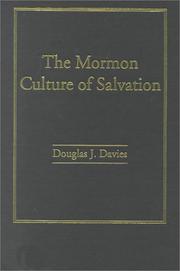
ISBN: 0754613283 0754613305 9780754613282 9780754613305 Year: 2002 Publisher: Aldershot, hants Ashgate Publishing Limited
Abstract | Keywords | Export | Availability | Bookmark
 Loading...
Loading...Choose an application
- Reference Manager
- EndNote
- RefWorks (Direct export to RefWorks)
Mormon Church --- Salvation --- Eschatology --- Eglise mormone --- Salut --- Eschatologie --- Church of Jesus Christ of Latter-Day Saints --- Doctrines --- Mormon Church. --- Doctrines. --- 289.3 --- Mormonen. Church of Jesus Christ of Latter Day Saints --- 289.3 Mormonen. Church of Jesus Christ of Latter Day Saints --- Church of Jesus Christ of Latter-day Saints --- Biserica lui Isus Hristos a Sfinților din Zilele din Urmă --- Corporation of the President of the Church of Jesus Christ of Latter-Day Saints --- Cerkev Jezusa Kristusa svetih iz poslednjih dni --- Chiesa di Gesù Cristo dei Santi degli Ultimi Giorni --- Crkva Isusa Krista Svetaca Posljednjih Dana --- Cirkev Jez̆is̆a Krista Svätých neskors̆ích dní --- Církev Jez̆ís̆e Krista Svatých posledních dnů --- Església de Jesucrist dels Sants dels Darrers Dies --- Église de Jésus-Christ des Saints des Derniers Jours --- Ekklēsia tou Iēsou Christou tōn Agiōn tōn Teleutaiōn Ēmerōn --- Esucristo ittoed nega esordamar napi puguad onosa --- Gereja Yesus Kristus Dari Orang-Orang Suci Zaman Akhir --- Giáo hội các thánh hữu ngày sau của Chúa Giê su Ky tô --- Hisus Kʻristosěn Akhěr-Kiwnlēr Mugattēslēri Kʻilisēsi --- Hisus Kʻristosi Verjin-Awur Srbotsʻ Ekeghetsʻi --- Hisus Kʻristosi Verjin Ōreri Srberi Ekeghetsʻi --- Hisus Kʻristosi Verjin Ōreri Srberi Ekeghetsʻu koghmitsʻ --- Iglesia de Jesucristo de los Santos de los Últimos Días --- Igreja de Jesus Cristo dos Santos dos Últimos Dias --- Iyēcu Kiristuvin̲ Tiruccapai --- Jesu Kristi kirke af sidste dages hellige --- Jesu Kristi kirke av siste dagers hellige --- Jesu Kristi Kyrka av Sista Dagars Heliga --- Jesus Christ N'ascr a Cwc Hc Ma Ekyrmba Ahotseweelfo --- Jesucriston Khep Khepürunacanquiri Kollananac Tamapan mistuyata --- Kanīsat Yasūʻ al-Masīḥ li-Qiddīsī al-Ayyām al-Akhīrah --- Kerk van Jesus Christus van die Heiliges van die Laaste Dae --- Kerk Van Jezus Christus Van De Heiligen Der Laatste Dagen --- Kirche Jesu Christi der Heiligen der Letzten Tage --- Kirkja Jesú Krists hinna Síđari daga heilögu --- Kisha e Jezu Krishtit e Shenjtorëve të Ditëve të Mëvonshme --- Kościół Jezusa Chrystusa Świętych w Dniach Ostatnich --- LDS Church (Church of Jesus Christ of Latter-day Saints) --- Myöhempien Aikojen Pyhien Jeesuksen Kristuksen Kirkko --- Pēdējo Dienu Svēto Jēzus Kristus Baznīca --- Ri Ruk'ataj ri Jesucristo quichin ri Chojlaxela' chupan ri ruq'uisibel tak K'ij --- Simbahan ni Jésukristo sa mga Santos sa Ulahing mga Adlaw --- T︠s︡ŭrkvata na Isus Khristos na svetiite ot poslednite dni --- Utolsó Napok Szentjeinek Jézus Krisztus Egyháza --- Viimse Aja Pühade Jeesuse Kristuse Kirik --- Εκκλησία του Ιησού Χριστού των Αγίων των Τελευταίων Ημερών --- كنيسة يسوع المسيح لقديسي الأيام الأخيرة --- Церкви Иисуса Христа Святых последних дней --- Церкви Ісуса Христа Святих Останніх Днів --- 耶穌基督末世聖徒教會 --- 耶蘇基督末世聖徒教會 --- 末日聖徒イエス・キリスト教会 --- Esu̇s Khristiĭn Khozhmyn U̇eiĭn Gėgėėntnu̇u̇diĭn Su̇m --- Reorganized Church of Jesus Christ of Latter Day Saints --- Church of Jesus Christ (Bickertonites) --- Church of the Firstborn of the Fulness of Times --- Church of Jesus Christ (Strangites) --- Simbahan ni Jesucristo sang mga Santos sa Ulihing mga Adlaw --- Relief Society (Church of Jesus Christ of Latter-day Saints) --- Church Educational System (Church of Jesus Christ of Latter-day Saints) --- Unified Church School System (Church of Jesus Christ of Latter-day Saints) --- Salvation - Mormon Church. --- Mormon Church - Doctrines. --- Mormonism --- Christian sects --- salvation --- Christianity --- exaltation --- death --- Temple Mormonism --- embodiment --- the temporal world --- domestic Mormonism --- Ward Mormonism --- charisma --- bureaucracy
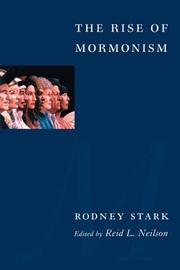
ISBN: 023113634X 023150991X Year: 2005 Publisher: New York : Columbia University Press,
Abstract | Keywords | Export | Availability | Bookmark
 Loading...
Loading...Choose an application
- Reference Manager
- EndNote
- RefWorks (Direct export to RefWorks)
Will Mormonism be the next world faith, one that will rival Catholicism, Islam, and other major religions in terms of numbers and global appeal? This was the question Rodney Stark addressed in his much-discussed and much-debated article, "The Rise of a New World Faith" (1984), one of several essays on Mormonism included in this new collection. Examining the religion's growing appeal, Rodney Stark concluded that Mormons could number 267 million members by 2080. In what would become known as "the Stark argument," Stark suggested that the Mormon Church offered contemporary sociologists and historians of religion an opportunity to observe a rare event: the birth of a new world religion.In the years following that article, Stark has become one of the foremost scholars of Mormonism and the sociology of religion. This new work, the first to collect his influential writings on the Mormon Church, includes previously published essays, revised and rewritten for this volume. His work sheds light on both the growth of Mormonism and on how and why certain religions continue to grow while others fade away. Stark examines the reasons behind the spread of Mormonism, exploring such factors as cultural continuity with the faiths from which it seeks converts, a volunteer missionary force, and birth rates. He explains why a demanding faith like Mormonism has such broad appeal in today's world and considers the importance of social networks in finding new converts. Stark's work also presents groundbreaking perspectives on larger issues in the study of religion, including the nature of revelation and the reasons for religious growth in an age of modernization and secularization.
Mormons --- History --- Histoire --- Church of Jesus Christ of Latter-day Saints --- Mormon Church --- History. --- United States --- Etats-Unis --- Church history. --- Histoire religieuse --- 289.3 --- -Mormonism --- Christian sects --- Mormonen. Church of Jesus Christ of Latter Day Saints --- Biserica lui Isus Hristos a Sfinților din Zilele din Urmă --- Corporation of the President of the Church of Jesus Christ of Latter-Day Saints --- Cerkev Jezusa Kristusa svetih iz poslednjih dni --- Chiesa di Gesù Cristo dei Santi degli Ultimi Giorni --- Crkva Isusa Krista Svetaca Posljednjih Dana --- Cirkev Jez̆is̆a Krista Svätých neskors̆ích dní --- Církev Jez̆ís̆e Krista Svatých posledních dnů --- Església de Jesucrist dels Sants dels Darrers Dies --- Église de Jésus-Christ des Saints des Derniers Jours --- Ekklēsia tou Iēsou Christou tōn Agiōn tōn Teleutaiōn Ēmerōn --- Esucristo ittoed nega esordamar napi puguad onosa --- Gereja Yesus Kristus Dari Orang-Orang Suci Zaman Akhir --- Giáo hội các thánh hữu ngày sau của Chúa Giê su Ky tô --- Hisus Kʻristosěn Akhěr-Kiwnlēr Mugattēslēri Kʻilisēsi --- Hisus Kʻristosi Verjin-Awur Srbotsʻ Ekeghetsʻi --- Hisus Kʻristosi Verjin Ōreri Srberi Ekeghetsʻi --- Hisus Kʻristosi Verjin Ōreri Srberi Ekeghetsʻu koghmitsʻ --- Iglesia de Jesucristo de los Santos de los Últimos Días --- Igreja de Jesus Cristo dos Santos dos Últimos Dias --- Iyēcu Kiristuvin̲ Tiruccapai --- Jesu Kristi kirke af sidste dages hellige --- Jesu Kristi kirke av siste dagers hellige --- Jesu Kristi Kyrka av Sista Dagars Heliga --- Jesus Christ N'ascr a Cwc Hc Ma Ekyrmba Ahotseweelfo --- Jesucriston Khep Khepürunacanquiri Kollananac Tamapan mistuyata --- Kanīsat Yasūʻ al-Masīḥ li-Qiddīsī al-Ayyām al-Akhīrah --- Kerk van Jesus Christus van die Heiliges van die Laaste Dae --- Kerk Van Jezus Christus Van De Heiligen Der Laatste Dagen --- Kirche Jesu Christi der Heiligen der Letzten Tage --- Kirkja Jesú Krists hinna Síđari daga heilögu --- Kisha e Jezu Krishtit e Shenjtorëve të Ditëve të Mëvonshme --- Kościół Jezusa Chrystusa Świętych w Dniach Ostatnich --- LDS Church (Church of Jesus Christ of Latter-day Saints) --- Myöhempien Aikojen Pyhien Jeesuksen Kristuksen Kirkko --- Pēdējo Dienu Svēto Jēzus Kristus Baznīca --- Ri Ruk'ataj ri Jesucristo quichin ri Chojlaxela' chupan ri ruq'uisibel tak K'ij --- Simbahan ni Jésukristo sa mga Santos sa Ulahing mga Adlaw --- T︠s︡ŭrkvata na Isus Khristos na svetiite ot poslednite dni --- Utolsó Napok Szentjeinek Jézus Krisztus Egyháza --- Viimse Aja Pühade Jeesuse Kristuse Kirik --- Εκκλησία του Ιησού Χριστού των Αγίων των Τελευταίων Ημερών --- كنيسة يسوع المسيح لقديسي الأيام الأخيرة --- Церкви Иисуса Христа Святых последних дней --- Церкви Ісуса Христа Святих Останніх Днів --- 耶穌基督末世聖徒教會 --- 耶蘇基督末世聖徒教會 --- 末日聖徒イエス・キリスト教会 --- Reorganized Church of Jesus Christ of Latter Day Saints --- Church of Jesus Christ (Bickertonites) --- Church of the Firstborn of the Fulness of Times --- Church of Jesus Christ (Strangites) --- Simbahan ni Jesucristo sang mga Santos sa Ulihing mga Adlaw --- Relief Society (Church of Jesus Christ of Latter-day Saints) --- Church Educational System (Church of Jesus Christ of Latter-day Saints) --- Unified Church School System (Church of Jesus Christ of Latter-day Saints) --- history. --- -Mormonen. Church of Jesus Christ of Latter Day Saints --- 289.3 Mormonen. Church of Jesus Christ of Latter Day Saints --- -289.3 Mormonen. Church of Jesus Christ of Latter Day Saints --- Mormonism --- Esu̇s Khristiĭn Khozhmyn U̇eiĭn Gėgėėntnu̇u̇diĭn Su̇m --- Latter Day Saints --- Latter Day Saint churches --- Mormon history --- Joseph Smith --- the revelators --- Mormon sacrifice --- modernization --- secularization
| Listing 1 - 10 of 56 | << page >> |
Sort by
|

 Search
Search Feedback
Feedback About UniCat
About UniCat  Help
Help News
News